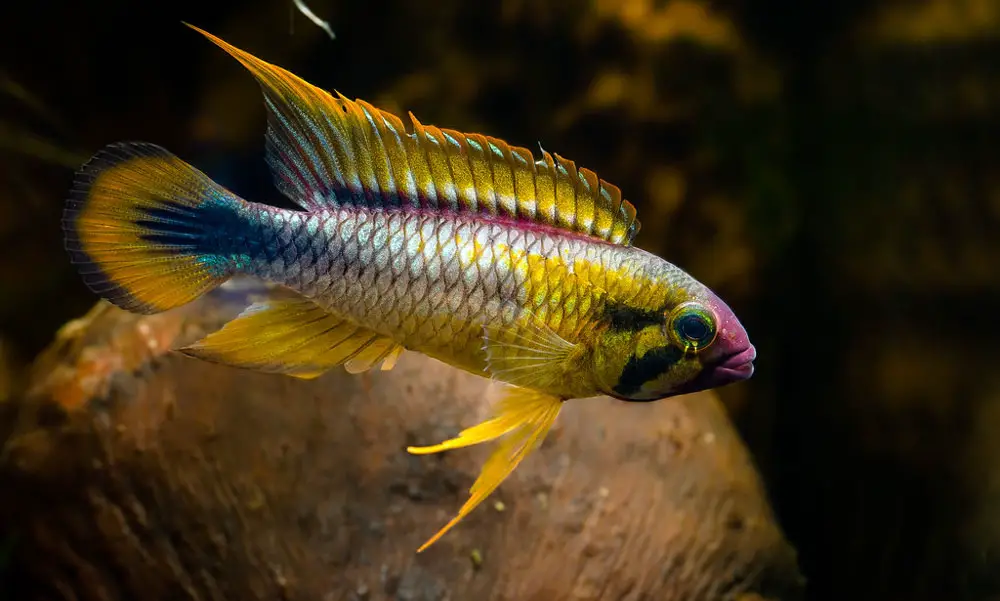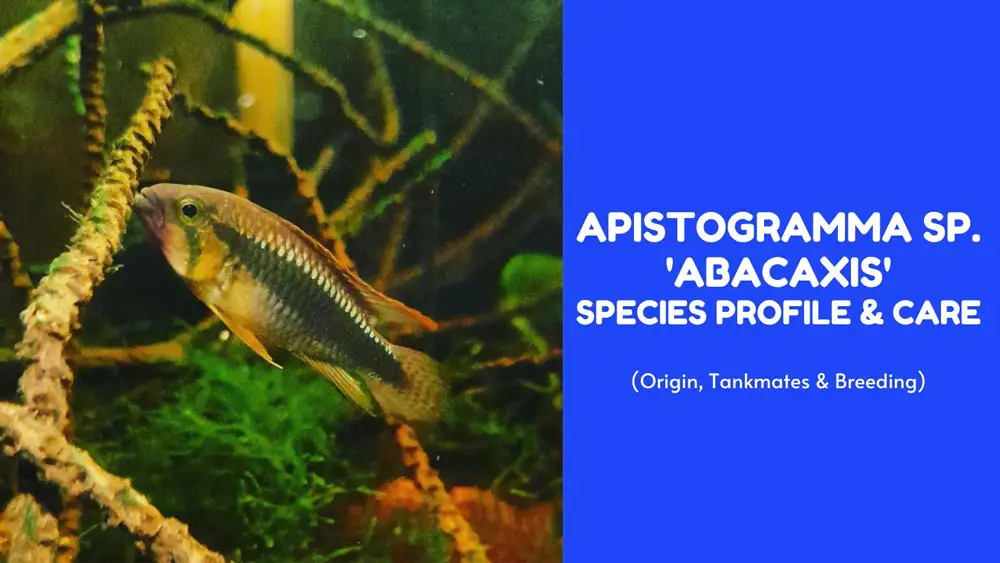If you’re looking for an eye-catching Apisto to elevate the look of your display tank, give the Apistogramma sp. ‘abacaxis’ a try. This rare, vibrant species is an absolute showstopper with its striking colors and patterned fins.
However, even experienced Apisto keepers often find it can be challenging to care for them in captivity, especially when attempting reproduction, due to their need for very specific water conditions.
In this guide, you’ll learn what it takes to care for this more high-maintenance Apistogramma species.
Species Overview
| Scientific Name: | – |
| Common Name: | Apistogramma sp. ‘abacaxis’, Apistogramma sp. ‘wilhelmi’, Rio Abacaxis Dwarf Cichlid |
| A-number: | A 227, A 228 |
| Origin: | Lake Lago Glemende, Rio Abacaxis, Brazil |
| Family: | Cichlidae |
| Lineage: | trifasciata |
| Group: | pulchra |
| Max Size: | 2 to 4 inches (5-10 cm) |
| Social: | Semi-aggressive |
| Care: | Intermediate |
| Lifespan: | 2 ~ 5 years |
| pH: | 4.0 – 5.0 |
| Temperature: | 77-86° F (25-30 °C) |
| Hardness: | up to 3 degrees |
| TDS: | < 20 |
| Diet: | Carnivore |
| Tank Size: | 30 gallons |
Origin and Distribution
The Apistogramma sp. ‘abacaxis’ has not yet been scientifically documented since it was first collected during an expedition to Brazil in 1999 by Mario Wilhelm and Horst Linke.
These wild-caught specimens were then propagated in captivity by Mario Wilhelm and his father, the well-known German breeder Frank Wilhelm. A year later, Linke introduced this species to the hobby under the common name of Apistogramma sp. ‘wilhelmi.’
However, the species name ‘wilhelmi’ is thought to describe a scientifically described species, given the standard terms of species taxonomy nomenclature. For this reason, it’s now more commonly referred to as Apistogramma sp. ‘abacaxis,’ named for its distribution.
In the wild, A. sp. ‘abacaxis’ is native to Lago Glemende, a small jungle lake connected to the Rio Abacaxis by a small stream near the village of Walendo in northwestern Brazil. The Rio Abacaxis is a blackwater tributary of the lower Rio Madeira and is also known as the natural habitat of the ‘Heckel’ and ‘abacaxi’ discus. In the DATZ’s A-number system, the Abacaxis population is assigned A 227.
You may have heard of or seen the other form of A. sp. ‘abacaxis’ in the fish trade, sold as Apistogramma cf. pulchra ‘abacaxis,’ Apistogramma cf. pulchra ‘marimari,’ or A 228. This population was found in the Rio Marimari, a right tributary of the Rio Abacaxis, and was introduced in Japan in 2002 under the trading name “Apistogramma pulchra ‘marimari’.”
Despite sharing some characteristics with Apistogramma pulchra, this population is more likely a geographic form of Apistogramma sp. ‘Abacaxis’ (A 227) because they look virtually identical in color and markings.
Apistogramma sp. ‘abacaxis’: A227 Vs. A228
The subtle differences between A227 and A228 including:
- In A 228, the spacing between the rows of dark spots on the caudal fin is wider than that in A 227.
- The lateral band of the A 227 extends slightly into the caudal peduncle, whereas in A 228, it extends further, almost beyond the middle portion.
- In A 228, the red color on the lips and throat is more intense.
How to Identify an Apistogramma sp. ‘abacaxis’?

Identifying a specific species of Apistogramma isn’t always easy. As a rule of thumb, knowing where the species is placed within the phylogeny for Apistogramma species groups, which is organized based on biogeographic patterns and distributions, can be helpful.
Today, the widely-used phylogeny proposed by Mike Wise classifies Apistogramma species into 24 different species complexes and 16 species groups within four distinct lineages.
The Apistogramma sp. ‘abacaxis’ falls into the pulchra species group, which is a part of the agassizii group under the trifasciata lineage.

The members of the agassizii group are relatively large Apistos that have elongated, torpedo-shaped bodies with wider and more prominent lateral line bars.
Additionally, all species in the pulchra complex feature a rounded caudal fin covered in dark spots more or less arranged in concentric rows.
The main identifying trait of A. sp. ‘abacaxis’ is the deep red coloration of its mouth in dominant males.
How Big Do Apistogramma sp. ‘abacaxis’ Get?
Reaching an adult size of 2 to 4 inches (5-10 cm) in length (TL) with a very slender profile, they are large on the Apistogramma scale.

How to Set Up an Aquarium for Apistogramma sp. ‘abacaxis’?
As you probably already know, most species of the pulchra complex are found in the leaf-litter-strewn blackwater habitats of the Rio Negro, Rio Uatumã, and Rio Madeira – three blackwater rivers that flow through moist forests.
The waters of lake Lago Glemende, Rio Madeira, and Rio Marimari are typically very soft, acidic, and tinted with tannins, so it’s important that you replicate such conditions in the aquarium if you want to give your “abacaxis” a good quality of life.
Creating a Rio Negro blackwater biotope is definitely not as easy as pie; it involves a bit of work to adjust the pH and TDS levels, particularly the latter. The difficulty comes in because of their water requirements, which make them more suitable for experienced aquarists.
Apistogramma bitaeniata, or A 216, is also native to the Rio Madeira. If you can't find a resource for A. sp. 'abacaxis', try A. bitaeniata instead.
Tank Size
Bigger is always better. The minimum tank size depends on your setup. For a 30-gallon breeder tank (36″ x 18″ x 12″), keep no more than one male. For a 75-gallon community tank (48″ x 18″ x 21″) or larger, start with three males with four to six females. Ensure that each female has at least 12″ x 12″ space to establish her territory.
Remember that the males of Apistogramma sp. ‘abacaxis’ are polygamous and often display territorial and aggressive behavior towards females. That’s why it’s recommended to keep them in a harem consisting of one male and at least two females.
Habitat & Water Conditions
In Lago Glemende, their prime location is along a shallow shoreline covered with brush and leaf litter. Such habitat has very low mineral content, which results in an extremely low TDS, sometimes even below 5.0.
The water is on the acidic side and quite soft, with a pH of 4.0 or below, and both GH and KH are no more than 1.
- Temperature: 77-86° F (25-30 °C)
- pH: 4.0 – 5.0
- Hardness: up to 3 degrees
- TDS: < 20
In captivity, they can tolerate a wide range of water hardness levels and may even spawn; however, the hatching rate of their eggs significantly decreases in more alkaline water.
To aid in the simulation of blackwater conditions, a good practice is to use a RO/DI system and add more catappa leaves and softwoods to the tank. Based on the results, you may need to amend the water by adding a small net bag filled with peat moss to the filter, which helps to filter out minerals.
Substrate, Lighting & Plants
When it comes to building the ideal low-light habitat for your A. sp. ‘abacaxis,’ a dark-colored substrate and background are recommended.
Given their aggressive behavior, providing desired territory or hiding spots with, either plants or other Apisto caves, is critical to reducing their stress level. Make sure that the plants can tolerate low-light and blackwater environments. Ceratopteris thalictroides, Hydrocotyle leucocephala, and Limnobium laevigatumare all good options.
In terms of lighting, without a doubt, it should be dim. Place some floating plants to ensure the tank remains dark.
What Do A. sp. ‘abacaxis’ Eat?
As with all Apistogramma species, A. sp. ‘abacaxis’ is a carnivore that feeds on a variety of mollusks and other small invertebrates in nature. They enjoy eating live or frozen foods like mosquito larvae, baby brine shrimp, and small worms in the aquarium. Often, they will accept a carnivore pellet.
Behavior & Tank Mates
As mentioned, A. sp. ‘abacaxis’ is a polygamous species. When kept in small tanks, aggression between females or between a male and a female who is not ready to spawn can be deadly. Keeping them in a harem with at least two females for each male is the best way to eliminate aggression.
In its natural habitat, Lake Lago Glemende, only a few small tetras coexist with this species due to the water chemistry. Therefore, setting up a species-specific tank with a large school of them, complemented by live plants, not only looks stunning but also increases the chance of acquiring a breeding pair.
Gender Differences
Males are identified by their dark red lips. The belly of mature females who are ready to spawn will turn brownish yellow to bright yellow in color. The males are also slightly larger and have longer fins.
How to Breed Apistogramma sp. ‘abacaxis’?
If you’re looking to breed fish, you can use the group method (as mentioned) to obtain an established breeding pair or purchase a mating pair or trio from private breeders. Considering the high price tag and polygamous mating behavior, the former option is more economical.
Once you have the best-looking pair or a trio, breeding should be fairly easy. Since this secretive cave spawner may not feel comfortable enough to breed in a community tank, a separate breeding tank is necessary.
To increase the chances of success, condition the fish with live foods and give them ample hiding spots and territory in the tank.
For spawning, the correct water parameters must be met as follows.
- Temperature: 79° F (26 °C)
- pH: < 5
- KH: 0
- GH: 0
- TDS: < 20
It is worth noting that Temperature-Dependent Sex Determination (TSD) is very common in Apistogramma species, including Apistogramma sp. ‘abacaxis.’ For this species, the balanced temperature for the production of a 1:1 sex ratio is 79° F (26 °C). If you want more males, raise the temperature; lower it for more females.
How many eggs do Apistogramma sp. ‘abacaxis’ lay? Each successful spawn can produce up to fifty eggs in the selected spawning cave. In the wild, females typically lay their eggs in leaf litter or under the wood. A half coconut shell and ceramic plant pots can be used in a breeding tank as spawning sites.
Once the eggs have been laid, the female becomes aggressive toward the male, at which point he should be removed from the tank to prevent the brooding female from eating the eggs.
The fish fry usually hatch in 3 days and will be free swimming after 4 days. The fry should be fed with very fine micro-foods initially, like infusoria or vinegar eels, until they are big enough to consume freshly hatched brine shrimp.
Closing Thoughts
The Apistogramma sp. ‘abacaxis’ is one of the rare Apistos in the trade. If you are unable to find them at your local fish store, there is always the option of buying from online vendors.
This species requires special blackwater conditions to thrive. If you can provide the correct water parameters and plenty of space, Apistogramma sp. ‘abacaxis’ will reward you with a beautiful display of colors as well as some fascinating parental care behavior.
References:
- Mike Wise October, 2021. A Description of Apistogramma Species-Groups
- Wise, Mike. (Jan 04, 2008). “Apistogramma sp. ‘wilhelmi'”. Cichlid Room Companion. Retrieved on Mar 22, 2023
- Apistogramma sp. “abacaxis” A227, A228 | ciklid.org
- Ospina-Alvarez N, Piferrer F. Temperature-dependent sex determination in fish revisited: prevalence, a single sex ratio response pattern, and possible effects of climate change. PLoS One. 2008
- Römer, Uwe. 1994. “Apistogramma mendezi nov. sp. (Teleostei: Perciformes; Cichlidae): description of a new dwarf cichlid from the Rio Negro system, Amazonas State, Brazil”. Aqua: Journal of Ichthyology and Aquatic Biology.
